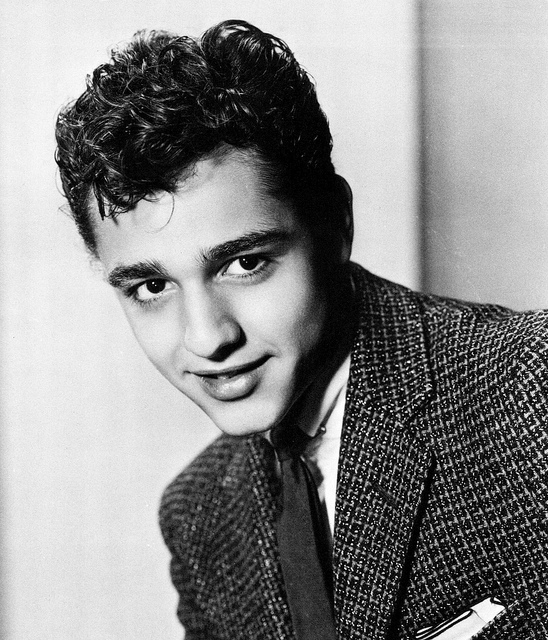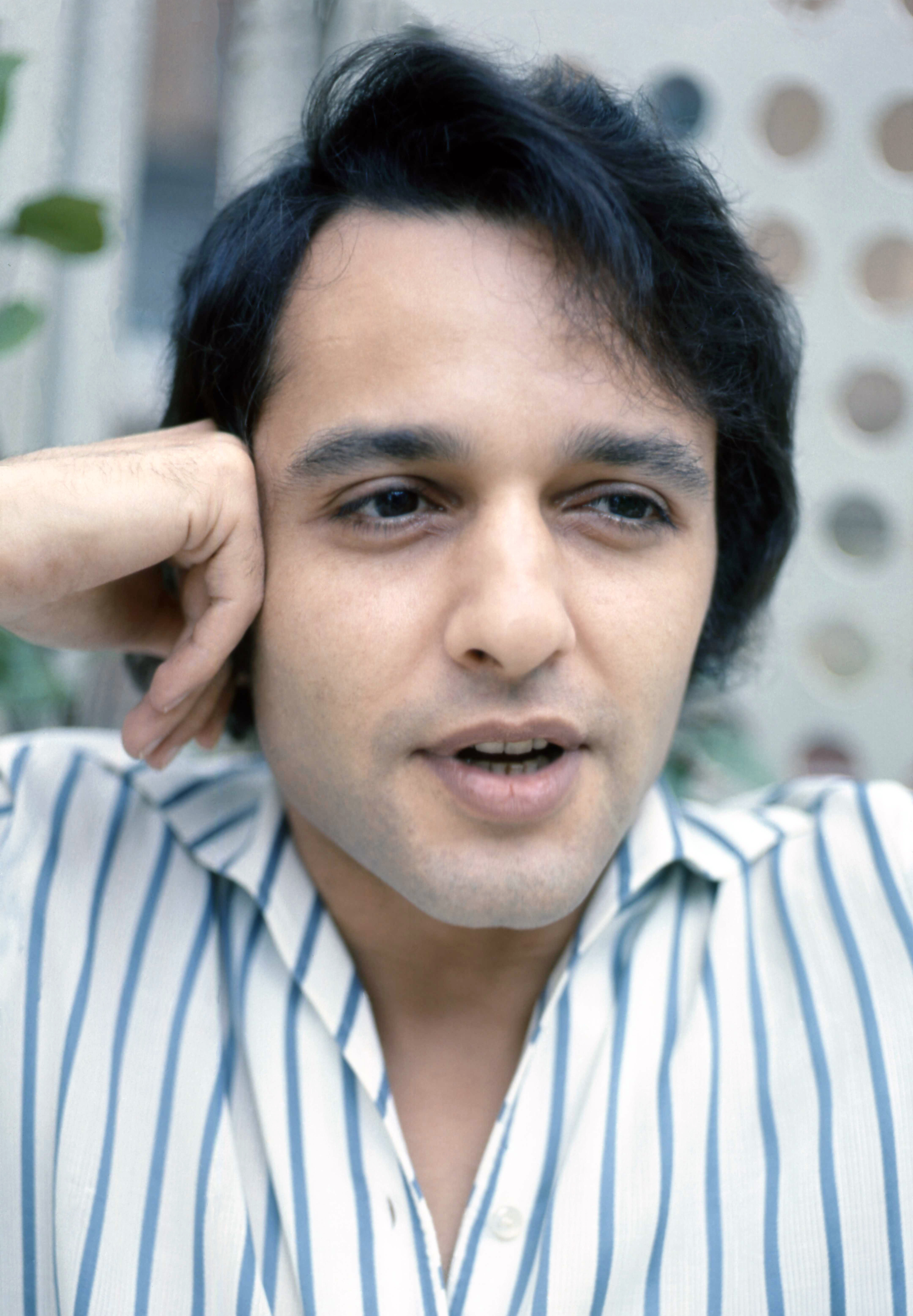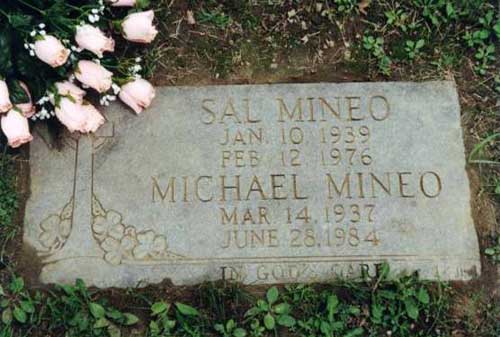Sal Mineo (Salvatore Mineo)

Mineo was born in the Bronx, the son of coffin makers Josephine (née Alvisi) and Salvatore Mineo, Sr. He was of Sicilian descent; his father was born in Italy and his mother, of Italian origin, was born in the United States. His mother enrolled him in dancing and acting school at an early age. He had his first stage appearance in The Rose Tattoo (1951), a play by Tennessee Williams. He also played the young prince opposite Yul Brynner in the stage musical The King and I. Brynner took the opportunity to help Mineo better himself as an actor. As a teenager, Mineo appeared on ABC’s musical quiz program Jukebox Jury, which aired in the 1953-1954 season. Mineo made several television appearances before making his screen debut in 1955 in the Joseph Pevney film Six Bridges to Cross. He beat out Clint Eastwood for the role. Mineo had also successfully auditioned for a part in The Private War of Major Benson as a cadet colonel opposite Charlton Heston.
His breakthrough as an actor came in Rebel Without a Cause, in which he played John “Plato” Crawford, the sensitive teenager smitten with Jim Stark (played by James Dean). His performance resulted in an Academy Award nomination for Best Supporting Actor, and his popularity quickly developed. Mineo’s biographer, Paul Jeffers, recounted that Mineo received thousands of letters from young female fans, was mobbed by them at public appearances and further wrote, “He dated the most beautiful women in Hollywood and New York.”
In Giant (1956), Mineo played Angel Obregon II, a Mexican boy killed in World War II; but many of his subsequent roles were variations of his role in Rebel Without a Cause, and he was typecast as a troubled teen. In the 1959 Disney adventure Tonka, for instance, Mineo starred as a young Sioux named White Bull who traps and domesticates a clear-eyed, spirited wild horse named “Tonka” who becomes the famous Comanche, the lone survivor of Custer’s Last Stand. In Multiculturalism and the Mouse: Race and Sex in Disney Entertainment (2006), Douglas Brode states that the casting of Mineo as White Bull again “ensured a homosexual subtext”. By the late 1950s the actor was a major celebrity, sometimes referred to as the “Switchblade Kid”—a nickname he earned from his role as a criminal in the movie Crime in the Streets.
In 1957, Mineo made a brief foray into pop music by recording a handful of songs and an album. Two of his singles reached the Top 40 in the United States Billboard Hot 100. The more popular of the two, “Start Movin’ (In My Direction)”, reached #9 on Billboard’s pop chart. It sold over one million copies and was awarded a gold disc. He starred as drummer Gene Krupa in the movie The Gene Krupa Story, directed by Don Weis with Susan Kohner, James Darren and Susan Oliver. Mineo made an effort to break his typecasting. His acting ability and exotic good looks earned him roles as the Native American boy in Tonka, and as a Jewish emigrant in Otto Preminger’s Exodus, for which he won a Golden Globe Award and received another Academy Award nomination as Best Supporting Actor.
By the early 1960s he was becoming too old to play the type of role that had made him famous and his homosexuality led to him being not considered appropriate for leading roles. He auditioned for David Lean’s film Lawrence of Arabia, but was not hired.[6] Mineo was baffled by his sudden loss of popularity, later saying “One minute it seemed I had more movie offers than I could handle; the next, no one wanted me”. The high point of this period was his portrayal of Uriah in The Greatest Story Ever Told. Mineo also appeared on The Patty Duke Show in its second season (1964). The episode was called “Patty Meets a Celebrity”. There are stories he attempted to revive his career by camping out on the front lawn of Francis Ford Coppola’s home, for a chance to win the role of Fredo in The Godfather, but the role went to John Cazale. Mineo guest starred in an episode of ABC’s TV series Combat! in 1966, playing the role of a G.I. wanted for murder. He did 2 more appearances on the same show, including appearing in an installment with Fernando Lamas.
Mineo’s role as a stalker in Who Killed Teddy Bear? (1965), which co-starred Juliet Prowse, did not seem to help. Although his performance was praised by critics, he found himself typecast anew, now as a deranged criminal. He never entirely escaped this fact. One of his last roles was a guest spot on the TV series S.W.A.T. (1975), playing a cult leader similar to Charles Manson. In 1969, Mineo returned to the stage to direct a Los Angeles production of the gay-interest 1967 play Fortune and Men’s Eyes, featuring then-unknown Don Johnson as Smitty and himself as Rocky. The production got positive reviews, although its expanded prison rape scene was criticized as excessive and gratuitous. In 1970, Mineo was crowned King of the Beaux Arts Ball. Presiding with him as his Queen was Madeleine Le Roux. A small role in the film Escape from the Planet of the Apes (1971) as the chimpanzee, Dr. Milo, was Mineo’s last appearance in a motion picture. In 1976, Mineo appeared as Rachman Habib, assistant to the president of a Middle Eastern country, in the episode “A Case of Immunity” on the NBC-TV crime drama Columbo. He also appeared in two episodes of Hawaii Five-O, in 1968 and 1975. In the late 1960s Mineo became one of the first major actors in Hollywood to publicly acknowledge his homosexuality.
By 1976 Mineo’s career had begun to turn around. While playing the role of a bisexual burglar in a series of stage performances of the comedy, P.S. Your Cat Is Dead, in San Francisco, Mineo received substantial publicity from many positive reviews, and he moved to Los Angeles along with the play. Mineo was arriving home after a rehearsal on February 12, 1976, when he was stabbed to death in the alley behind his apartment building in West Hollywood, California. Mineo was stabbed just once, not repeatedly as first reported, but the knife blade struck his heart, leading to immediate and fatal internal bleeding. His remains were interred in the Gate of Heaven Cemetery in Hawthorne, New York.
Born
- January, 10, 1939
- USA
- The Bronx, New York
Died
- February, 12, 1976
- USA
- West Hollywood, California
Cause of Death
- Internal bleeding from stab wound
Cemetery
- Gate of Heaven Cemetery
- Hawthorne, New York
- USA




